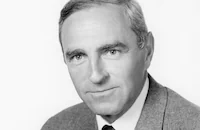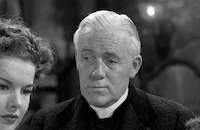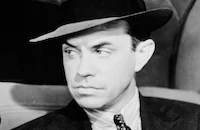Follow Me Quietly

Brief Synopsis
Cast & Crew
Richard O. Fleischer
William Lundigan
Dorothy Patrick
Jeff Corey
Nestor Paiva
Charles D. Brown
Film Details
Technical Specs

Synopsis
At a café one rainy night, Ann Gorman, a writer for Four Star Crime magazine, seeks out police lieutenant Harry Grant with questions about "The Judge," a serial killer who only attacks when it rains. Harry rejects Ann's pleas for information, however, and leaves with his partner, Sgt. Art Collins, when a call comes in about an attack on a newspaper editor named McGill. Though badly injured, McGill describes how his assailant tried to strangle him in his office, but ended up pushing him out of his window during the struggle. McGill then dies before the police can obtain a description of the murderer, who Harry is convinced is The Judge.
Although over the months Harry has collected many clues regarding The Judge's appearance, habits and psychology, including the fact that he murders out of a sense of moral outrage, he has been unable to "put a face" to the killer. Out of frustration, Harry asks his forensic experts to construct a dummy replica of The Judge based on the clues he has collected, and soon a life-sized but faceless mannequin is created. The persistent Ann, meanwhile, continues to press Harry for information, and he finally signs an authorization form allowing her to write about the case, but stipulates that he has final approval over any story. When Harry later learns that Ann has used the authorization form to obtain information about the dummy, whose existence he wants to keep secret from the public, and has filed a story without consulting him, he angrily denounces her.
Harry then hears the confession of a man claiming to be The Judge, but soon unmasks him as a phony. Later, as rain begins to fall, the distraught Harry talks to the dummy in his darkened office, unaware that the dummy is actually The Judge. Sure that The Judge is going to strike that night, Harry then takes off in his car and drives around the city. He is soon joined by a contrite Ann, who tears up the authorization form as proof of her reformation. As predicted, The Judge strangles another seemingly random victim that night and leaves another clue for Harry--a year-old copy of Four Star Crime .
After studying the magazine, Ann concludes that the killer must have purchased it from a used book store. Harry, Art and Ann then canvas the city's book stores until they find a proprietor who confirms that a man whose build and dress match the dummy's buys crime magazines at his store. Assuming that the killer lives near the book store, Harry and Art canvas other area businesses and eventually find a café waitress who identifies the dummy as Charlie Roy, a nice man who lives around the corner. After inspecting Charlie's empty apartment, where they discover crime books and souvenirs from the murders, Harry and Art stake out his building. Sensing trouble, however, Charlie hesitates before entering, then flees down the street.
While chasing Charlie to the rooftop of a gas works plant, Harry loses his gun to his foe and is momentarily stunned by him. Soon, the plant is surrounded by police, who shoot at Charlie and hit a water tank. After Charlie fires all the bullets in Harry's pistol, Harry is able to corner and handcuff him at the top of a catwalk. As Harry is bringing Charlie out of the plant, however, the killer becomes hysterical when he sees water pouring out of the punctured tank like rain and begins to struggle with Harry, dragging him back up the catwalk by the handcuffs. Harry is finally able to free himself and pushes Charlie to his death. With the case solved, Harry and Ann then enjoy a quiet, romantic drink together.

Director

Richard O. Fleischer
Cast

William Lundigan

Dorothy Patrick

Jeff Corey

Nestor Paiva

Charles D. Brown

Paul Guilfoyle
Edwin Max

Frank Ferguson
Marlo Dwyer
Michael Branden

Douglas Spencer
Maurice Cass
Wanda Cantlon

Howard Mitchell
Cy Stevens
Robert Emmett Keane
Paul Bryar

Lee Phelps
Art Dupuis
Walden Boyle
Joe Whitehead
Martin Cichy
Michael Mark
Virginia Farmer
Nolan Leary
Crew
James Almond
James Altwies
C. Bakaleinikoff
Gordon Bau
Phil Brigandi
Charles Burke
James Casey
Albert S. D'agostino
Robert De Grasse
Lillie Hayward
Walter E. Keller
James Kurley
Annabelle Levy
Anthony Mann
W. H. Phillips
Clem Portman
Leonid Raab
Hazel Rogers
Francis Rosenwald
Herman Schlom
Ollie Sigurdson
Darrell Silvera
Anita Speer
Elmo Williams

Videos
Movie Clip


Trailer
Hosted Intro
Film Details
Technical Specs

Articles
Follow Me Quietly
Anthony Mann, future director of Winchester '73 (1950) and El Cid (1961), had written a treatment for Follow Me Quietly with Francis Rosenwald while he had been employed by RKO as a minor-league director in the mid 1940's. Finding no real use for his talents there, he had left to join Eagle-Lion, a poverty-row studio that churned out low-budget movies for the bottom of double-bills, and scored a huge critical success for the script and partial direction of He Walked by Night (1948). Police tracking a cop killer was the story but it was the way the script concentrated on the day-to-day work of a criminal investigation that intrigued reviewers.
RKO, noticing the reviews He Walked by Night received, dug through their papers and discovered Mann's earlier treatment for a similar story. Again the emphasis was on a policeman doing his duty but this time he was in pursuit of an insane serial killer who calls himself "The Judge." The killer is not seen as he stalks his victims in the rain, the apparent trigger for his murderous rages. Lt. Grant is assigned to find the Judge but the clues seem to lead nowhere so, trying to get inside the mind of the killer, Grant builds a life-size mannequin and sits it in the corner, spilling out his thoughts on the case to this surrogate.
As Mann was not available to direct, the movie was handed over to Richard Fleischer who turned out to have a sure hand when helming low-budget fast-paced thrillers. "This is the film that, above all, increased my knowledge of the trade. With Follow Me Quietly, I learned how to organize a film, allowing me to make the pursuit at the gas refinery more complex." Fleischer would go on to have a long career in directing, best known for his science fiction work Fantastic Voyage (1966) and Soylent Green (1973) although his early thriller work, such as Follow Me Quietly and The Narrow Margin (1952), is gaining new interest.
RKO did not spend much on this production, using William Lundigan and Dorothy Patrick as the leads, one of the rare times that they enjoyed that distinction (they were usually cast in supporting roles). However, the studio was willing to go for what really mattered, the film's visual look. Cinematographer Robert de Grasse, Academy Award-nominee for Vivacious Lady (1938) but, more appropriately photographer for the horror classic The Body Snatcher (1945), was brought aboard to provide the detailed lighting effects that gave this thriller an extra chill.
Variety praised the result as "a real perspiration-popper." At sixty minutes, Follow Me Quietly does its job of providing a taste of terror and a haunting vision of the dark side of the American city while offering some unexpected delights.
Director: Richard Fleischer
Producer: Herman Schlom
Writer: Lillie Hayward from a story by Francis Rosenwald and Anthony Mann
Cinematographer: Robert de Grasse
Editor: Elmo Williams
Music: Leonid Raab
Cast: William Lundigan (Harry Grant), Dorothy Patrick (Ann Gorman), Jeff Corey (Art Collins), Nestor Paiva (Benny), Charles D. Brown (Mulvaney), Paul Guilfoyle (Overbeck).
BW-60m. Closed captioning.
by Brian Cady

Follow Me Quietly
Quotes
Trivia
Notes
Contemporary news items add the following information about the production: Francis Rosenwald and Anthony Mann's story was first purchased by Jack Wrather Productions, to be released by Allied Artists. Don Castle was to star for the Wrather production. In December 1947, RKO purchased the story from Wrather and assigned Martin Rackin to write the script. Rackin's contribution to the final film has not been confirmed. In June 1948, Kent Smith was announced as the film's star. As part of Hughes's new production arrangement at RKO, the picture's shooting schedule was only sixteen days, ten to twelve days less than the norm for previous "B" films.
















